Apr 28, 2011 | currency, review, technology
Following my review of EyeNote from the Bureau of Engraving and Printing, I was contacted Phillip Yang of Ipplex asking if I wanted to look at LookTel Money Reader. LookTel Money Reader is an iPhone application that performs the same functions as EyeNote, but I found to be even better.
According to the LookTel website, the app was developed by Ipplex under sponsorship from the National Institutes of Health (NIH) and was awarded two research grants from the National Eye Institute (NEI) and the National Institute on Aging (NIA). The app was awarded first place at the 2010 CTIA E-Tech Awards for Mobile Applications in the Healthcare category.
I was given a code from Mr. Yang to download the app for free. I did tell let Mr. Yang know that it receiving the app for free would not influence my review. The code was redeemed, downloaded to my iPhone 4, and started testing.
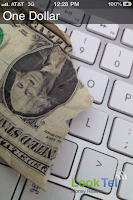 To use Money Reader, you start the app and move the note to be identified in front of the camera—no special positioning or clicking required. First, I grabbed the $1 note that one of my dogs used as a chew toy. Before I was able to situate the iPhone over the note, it caught a piece of it and started to speak, “One Dollar. One Dollar. One Dollar.” While the note is identifiable, Money Reader will speak the denomination until you move the note out of view. I moved the note, turned it over with the same result. The note was turned upside down, folded, moved in sideways, and Money Reader identified the note when about one-sixth of the note covered the screen.
To use Money Reader, you start the app and move the note to be identified in front of the camera—no special positioning or clicking required. First, I grabbed the $1 note that one of my dogs used as a chew toy. Before I was able to situate the iPhone over the note, it caught a piece of it and started to speak, “One Dollar. One Dollar. One Dollar.” While the note is identifiable, Money Reader will speak the denomination until you move the note out of view. I moved the note, turned it over with the same result. The note was turned upside down, folded, moved in sideways, and Money Reader identified the note when about one-sixth of the note covered the screen.
To say I was impressed with Money Reader’s performance would be an understatement. I had to try more. Using the money in my pocket, the app identified each note. It did not matter whether I used the front, back, turned the note upside down, sideways and even crumpled a one dollar note, all were identified.
 I tried to think about ways to fool the app. Rather than trying to identify a $10 note, I tried folding it to make the “10” look like something else. No matter what I tried, Money Reader identified it as a $10 note. A small pile of notes were also identified. Money Reader was also able to identify the last three generations of small $20 notes and a $2 note with a stamp and postmark from 1976. No matter what I tried to do, I could not confuse Money Reader.
I tried to think about ways to fool the app. Rather than trying to identify a $10 note, I tried folding it to make the “10” look like something else. No matter what I tried, Money Reader identified it as a $10 note. A small pile of notes were also identified. Money Reader was also able to identify the last three generations of small $20 notes and a $2 note with a stamp and postmark from 1976. No matter what I tried to do, I could not confuse Money Reader.
When I started to test Money Reader, it was during the day and the sun was out. The room I was in had the shades open. A few moments later a storm began rolling and and the room darkened. Money Reader was able to continue working after turning on the LED “flash” on the reverse of the iPhone 4. Obviously, this will be a problem for those using the iPhone 3Gs and iPod Touch that does not include the reverse LED.
I tried to identify multiple notes laying on a table or held in my hand. With similar notes, it was difficult to tell which note it was identifying. I used a set of $5 and $1 notes. While flipping the folded notes in my hand, Money Reader would identify the $1 I had just flipped and not the $5 note on top. It would be nice if the app could highlight or somehow indicate which note is being identified. When I made this comment to Mr. Yang, he said this is a planned future enhancement.
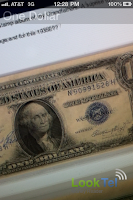 On a whim, I pointed Money Reader at my computer screen with an image of a $1 Silver Certificate. To my surprise, Money Reader identified the blue-sealed note properly!
On a whim, I pointed Money Reader at my computer screen with an image of a $1 Silver Certificate. To my surprise, Money Reader identified the blue-sealed note properly!
Money Reader is fast, accurate, and easier to use than EyeNote. It does not need instructions as EyeNote does because it just works. I love apps that just work! I also cannot believe that the app is $1.99—it is worth every cent and more! I grade this app PR69+. As we numismatists know, proof coins are specially made coins with high quality dies and planchets. Money Reader gives the appearance of specially made software of a very high quality justifying the PROOF grade. Money Reader gets the plus rating because of its superior performance and providing the “that’s neat” response. The slight confusion in identifying multiple notes in front of the camera prevents me from giving it a perfect PR70.
Here are the screen images of Money Reader I saved from my iPhone:
Apr 24, 2011 | coin design, commentary, nclt, US Mint
I’m bored with the America The Beautiful Quarters Program.
I’m bored with the commemorative coins that is produced by the U.S. Mint.
I’m bored with soap opera surrounding what U.S. Mint is going to do with the American Eagle coins.
I’m bored with many of the designs that the U.S. Mint has produced while ignoring the best efforts of the Citizens Coinage Advisory Committee and the U.S. Commission of Fine Arts to tell them otherwise.
I’m bored with what is coming out of the U.S. Mint and looking at the interesting collector coins coming out of other mints who are being more innovative with their designs. Where the U.S. Mint has produced one ultra-high relief coin, the Royal Canadian Mint has three high-relief coin designs for 2011.
I’m bored with the themes of the coins coming out of the U.S. Mint. While the Medal of Honor Commemorative is a worthy coin and one of the few good designs to come out of the U.S. Mint, but I am fascinated by what some of the other mints are doing. The Mongolia 2011 500 Tugrog Endangered Wildlife silver commemorative features the Ural Owl struck in high relief with an antique finish and Swarovski Crystal Eyes. This is part of the same series that produced the 2007 Wolverine coin that was named the 2009 Coin of the Year. It also was a high relief coin with an antique finish and Swarovski Crystal eyes. We have great artists in the United States, why can’t the U.S. Mint create coins like this?
Why can’t the U.S. Mint celebrate the history of auto making in the United States the way Tuvalu celebrates Classic Sports Cars or great American motorcycles the same way Somalia did in 2007?
My late mother was a fan of impressionism. She could tell you anything about the artists and the art of that era. One day, I showed here the 2007 Niue Island Van Gogh rectangular silver dollars and thought the design was one of the neatest things she saw. Every time I see on online I am reminded of her interest in a coin when she was not a coin collector. Could we interest others artists if the U.S. Mint created coins honoring American artists? Can you imagine what could be done with Georgia O’Keeffe’s flowers, Andy Warhol’s pop art, or even Louis Comfort Tiffany’s glass designs? These could become popular collectibles and generate significant seignorage for the U.S. Mint.
The reason why the U.S. Mint is behind the rest of the world is because of congress. Congress has taken its power to coin money and has clutched it in such a pedantic manner that it has turned the U.S. Mint into a tired looking organization that is falling behind the rest of the world. Although as a factory for circulating coin, the U.S. Mint produces more coins than any other world mint, they are losing the potential seignorage and artistic prestige to other mints that are producing interesting coins that people want to collect.
There is nothing in the constitution that says the U.S. Mint has to be structured the way it is. All we have is 219 years of “this is the way we wrote the law” that binds the United States to a system that is questioned every few years.
One idea is the model an independent U.S. Mint after the operating model of other world mints. One example that could be adopted is to model a new public corporation after the Royal Canadian Mint. While the RCM is required to produce circulating coinage for the Bank of Canada, they have a little more freedom to produce a portfolio of non-circulating legal tender coins that appears to have a broad appeal. Since many of these NCLT coins are made of precious metals, collectors and investors have been purchasing the RCM’s coins as investments.
As a public corporation, the U.S. Mint would continue to be required to supply circulating coins to the Federal Reserve, maintain the American Eagle Bullion program, and the current commemorative program. As a public corporation, they could add support for additional NCLT coins coins that could compete with other world mints to sell coins with great designs.
I realize that this is a very high-level idea of a new future for the U.S. Mint that requires additional details but it would be a waste of time to pursue this further. Given the personalities in congress who would have to approve such a measure, the chance of this happening is the same as the chance of ending the printing of the one-dollar note.
Apr 21, 2011 | currency, foreign
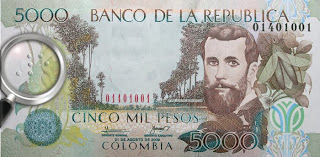 In March, the Banco de la Republica Colombia began circulating new 5,000 peso banknotes with the addition of the number 5 in Braille on the left side of the note. The Braille “5” is the only addition to the note that retains the previous design and security features.
In March, the Banco de la Republica Colombia began circulating new 5,000 peso banknotes with the addition of the number 5 in Braille on the left side of the note. The Braille “5” is the only addition to the note that retains the previous design and security features.
News stories from Colombia report that the COL$50,000 note include the number “50” in Braille in the bottom left next to the serial number. The COL$2,000 note includes the number “2” in Braille in the same location as the new COL$5,000 note.
The Colombian Central bank reports that it will be updating the rest of their banknotes to include the Braille numbers.
Colombian $5,000 note image courtesy of La República
Apr 20, 2011 | apps, BEP, review, technology
 The Bureau of Engraving and Printing will announce today that they have developed EyeNote,™ an app for iOS devices (iPhone, iPod Touch, iPad) that will help the assist the blind and visually impaired determine the value of the U.S. currency they are holding.
The Bureau of Engraving and Printing will announce today that they have developed EyeNote,™ an app for iOS devices (iPhone, iPod Touch, iPad) that will help the assist the blind and visually impaired determine the value of the U.S. currency they are holding.
According to the press release received this morning, EyeNote uses image recognition technology to determine a note’s denomination. The mobile device’s camera requires 51 percent of a note’s scanned image, front or back, to process. In a matter of seconds, EyeNote can provide an audible or vibrating response, and can denominate all Federal Reserve notes issued since 1996. The app will be updated as new notes are issued.
“Research indicates that more than 100,000 blind and visually impaired individuals currently own an Apple iPhone,” according to the BEP.
The EyeNote app is one of a variety of measures the government is working to deploy to assist the visually impaired community to denominate currency, as proposed in a recent Federal Register notice. These measures include implementing a Currency Reader Program whereby a United States resident, who is blind or visually impaired, may obtain a coupon that can be applied toward the purchase of a device to denominate United States currency; continuing to add large high contrast numerals and different background colors to redesigned currency; and, raised tactile features may be added to redesigned currency, which would provide users with a means of identifying each denomination via touch.
The app is only available for iOS devices. According to a representative from the BEP, “Future phone offerings cannot be definitely specified at this time, but there are tentative thoughts to make EyeNote available on other phones from other vendors once the iOS effort is launched.”
REVIEW
 After downloading the free app from the iTunes App Store, it was installed on my iPhone and I tried it. I had two notes nearby, a $20 note and a torn $1 note. When the app starts, there is a page with brief instructions. Interestingly, for an app that is supposed to help the visually impaired, the instruction text is a bit small that cannot be expanded using the iPhone pinch motion. For those who cannot read it, it says:
After downloading the free app from the iTunes App Store, it was installed on my iPhone and I tried it. I had two notes nearby, a $20 note and a torn $1 note. When the app starts, there is a page with brief instructions. Interestingly, for an app that is supposed to help the visually impaired, the instruction text is a bit small that cannot be expanded using the iPhone pinch motion. For those who cannot read it, it says:
Tap to begin. After beep, steady note 6 to 8 inches in front of the camera. Tap; shutter clicks; await result. Double tap to replay. Swipe left of right for spoken or privacy mode. In Voice OVer, single tap is double; double tap is triple. Switch out of VoiceOver to change spoken of privacy…
It seems the BEP needs to fix the grammar a bit.
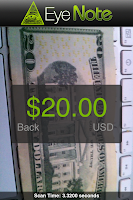 On my iPhone 4, the LED flash was turned on, I positioned a $20 note reverse in front of the camera, tapped the display, and the camera sound played as it took the picture. After a few seconds, a woman’s voice told me that it saw the back of the $20 note. I found a $10 and $50 note. Both were identified on both sides with no problems.
On my iPhone 4, the LED flash was turned on, I positioned a $20 note reverse in front of the camera, tapped the display, and the camera sound played as it took the picture. After a few seconds, a woman’s voice told me that it saw the back of the $20 note. I found a $10 and $50 note. Both were identified on both sides with no problems.
 After passing those tests, I tried the only $1 note I had: one that was used as a chew toy by one of my dogs. No matter how I positioned the camera, the app could not identify the note. While the app is impressive it would have been amazing if the app could have identified my torn note!
After passing those tests, I tried the only $1 note I had: one that was used as a chew toy by one of my dogs. No matter how I positioned the camera, the app could not identify the note. While the app is impressive it would have been amazing if the app could have identified my torn note!
It is very rare that an app’s first release is as impressive as EyeNote. However, it is not perfect. The opening screen needs to either have a voice over or larger text. The instruction text needs work and the controls need to be better explained. I grade this app MS68+*. Yes, it gets the plus rating for being excellent in what it does and the star because once you figure out the controls, it has great eye appeal. I am very impressed with the effort. I hope the BEP fixes the issues I found.
Click on any picture to see a larger version. Use your browser’s back button to return to the blog page.
Apr 20, 2011 | commentary, currency, policy, video
Should the United States stop producing $100 bills? According to Timothy Noah, a senior writer at Slate and contributor to CBS Sunday Morning, thinks so. Here is the report that Noah filed for CBS Sunday morning on April 3, 2011:
While a compelling argument but it is not a viable one. Because the U.S. Dollar is the most stable currency even considering our current economic situation, $100 notes will be hoarded overseas and will continued to be counterfeited. It has been reported that rogue nation states like North Korea have successfully counterfeited the $100 note which is why the Bureau of Engraving and Printing is working on its redesign. Having these note continue in circulation could endanger the U.S.
Further, it is doubtful the European Union will discontinue the $euro;500 note even though it is nicknamed “the Bin Laden.” The EU central bank would love to have the euro become the standard currency, the currency all economies are based. It would give more clout in the world markets and provide more incentives for the EU bankers to convince the worldwide commodity markets to price their goods and trade in euros, not dollars.
It is a different world from 1969 when the U.S. government ceased production of the $500 note. Between new counterfeiting measures and the technology to better investigate criminals, the U.S. Secret Service is better able to bring counterfeiters to justice and work with other law enforcement organizations to stop criminals. It is not a perfect system, but making any move that could lower the U.S.’s financial status with the rest of the world will not be well received in Washington.
Apr 19, 2011 | apps, books, review, technology
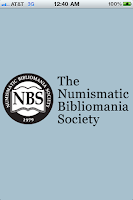 Speaking of apps, The Numismatic Bibliomania Society has created an app for its electronic newsletter, The E-Sylum.
Speaking of apps, The Numismatic Bibliomania Society has created an app for its electronic newsletter, The E-Sylum.
For those who have not heard of The Numismatic Bibliomania Society, NBS promotes the use and collection of all types of numismatic literature. The E-Sylum is their weekly electronic newsletter sent to email subscribers interested in numismatic literature and other topics of interest. It can be best described as eclectic with news, reviews, interesting numismatic tidbits, and discussions from a broad range of numismatists, authors, and collectors. It is worth subscribing or reading the issues on line.
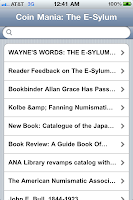 While catching up with reading back issues, I found the announcement and immediately downloaded the free app from iTunes App Store. After a quick sync, the application was on my iPhone and ready to use.
While catching up with reading back issues, I found the announcement and immediately downloaded the free app from iTunes App Store. After a quick sync, the application was on my iPhone and ready to use.
As with many apps, it opens with a splash screen with the NBS logo. After a few seconds, the app presents a list of articles from the most recent edition. So far so good as I tapped on the entry for the reader feedback on the app. I was then presented a page with the title of the article and a link that says “Read More.” I am not sure why the app does this. It should open the page with the text of the story. For me, this type of interface tends to become monotonous and turns me off to the app.
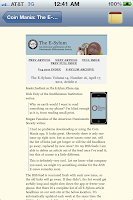 After pressing “Read More” I open up the web page from the NBS site with the story. The problem with this is that the article’s formatting is for a webpage to be read on the computer. This makes the text smaller and requires additional manual manipulation in order to read the article. I know it is possible for a website to tell what type of device is reading it. NBS should consider updating the style of the page to display better for the smaller phone screen when being read by the app.
After pressing “Read More” I open up the web page from the NBS site with the story. The problem with this is that the article’s formatting is for a webpage to be read on the computer. This makes the text smaller and requires additional manual manipulation in order to read the article. I know it is possible for a website to tell what type of device is reading it. NBS should consider updating the style of the page to display better for the smaller phone screen when being read by the app.
Another element I found curious is that the upper-left corner of the reading pane has what looks like a Notepad icon. I was not sure what it did so I pressed it. The article pane slid over revealing a light blue page with “Back” and “Save” buttons at the top of the screen. I am not sure what this does, but the screen stays blue and the “Save” button does not seem to do anything. At least the “Back” button slides the reading pane back into view.
I asked The E-Sylum editor Wayne Homren for his comment about my review. Wayne said, “I had a company plug our feed into one of their standard app configurations and publish it. I agree that the navigation could be (greatly!) improved. My goal would be to have an app that works more like The New York Times app I use every day, with an easy way to flick from story to story with a swipe of your finger.” It has the feel of a first version (“1.0”) app.
I really wanted to like this app but these issues may prevent me from using it on a regular basis. I hope that these issues will be fixed in a future release. Right now, I would give the app a grade of AU-58, just short of being mint state because of that blue screen that does not seem to do anything. I hope that NBS fixes the app because I really want to like it!
Here are the screen images of the app I saved from my iPhone:
Apr 19, 2011 | apps, books, grading, technology
 Coin World has announced the available of their app for the iPad. “The free app offers rich content such as the News and Marketplace features that are available at Coin World’s website.” The app is free and can be downloaded from Apple’s iTunes App Store.
Coin World has announced the available of their app for the iPad. “The free app offers rich content such as the News and Marketplace features that are available at Coin World’s website.” The app is free and can be downloaded from Apple’s iTunes App Store.
As part of the release, Coin World announced that Coin Values and Making the Grade are available as an in-app purchase. Coin Values, sometimes referred to as “Trends,” is their comprehensive value guide of more than 65,000 U.S. coins. It will cost $4.99 to purchase in the app. At this time, it may be the only price guide for mobile platforms.
Making the Grade is the electronic version of their popular grading guide book. It provides color image grading for 50 of the most widely collected U.S. coin series. The app leverages the iPad capabilities to zoom in on the images and adds the information about wearing for a coin. The book lists for $39.99 but will sell for $9.99 as an in-app purchase.
The Coin World app is only available for the iPad leaving those of us with only an iPhone out. iPhone users can download the PCGS Photograde app for the iPhone. Hopefully, Coin World will port this app to be used by the iPhone.
I will review the app when I purchase an iPad.
Apr 18, 2011 | books, coins, review
 Recently, I was sent a copy of Coins: Questions & Answers, Fifth Edition, by Cliff Mishler. Mishler is the current president of the American Numismatic Association.
Recently, I was sent a copy of Coins: Questions & Answers, Fifth Edition, by Cliff Mishler. Mishler is the current president of the American Numismatic Association.
Coins: Questions & Answers can best be described as a Frequently Asked Questions (FAQ) of coins with sections for paper money, Civil War era money whose section is entitled “Money of the War Between the States,” exonumia, and foreign coins. Each section covers the questions every collector should know about and even bring tidbits that escape even the most seasoned collected. For example, I learned that the word “Liberty” has been used on every coin except the Flying Eagle Cent and the Shield Nickel. It was thought the eagle and the union shield would satisfy the requirement.
For each coin type, the book seem to cover the basic information and some other fun facts about U.S. coins, including my favorite: which is the only coin with the portrait of the same person on the obverse and reverse? If you did not answer the Lincoln Memorial Cent, last struck in 2008, then maybe you should pick up a copy of the book!
One area that the book falls short is in the sections after the coins. There is a history of currency and questions I have seen on public forums that are not covered in this book. Some of the questions that are in the FAQ Library one the Bureau of Engraving and Printing website has some additional items that should appear in the book. One question that I people send me is what all the elements are on the U.S. Federal Reserve Note. These are not intuitive elements and I even forgot what each means (I use this page). An idea would be to produce a similar book for currency, separate from the coins.
Other sections do have enough information for a general purpose book. I am sure that there will be collectors looking for the more information on those topics. For those, Whitman does point to other books in its collation for more information. While they do this for the currency section, I think that currency is more mainstream that expanding this section would make the book more complete.
My one complaint is that the book does not have an index. While the reader can find the general area of their question using the table of contents, it would make a better reference if it included a fully referenced index.
Coins: Questions & Answers should not be your only reference, especially without an index, but it should be one of the books on your shelf. The answers are clear, concise, and those that require more than a paragraph are well written. For this book, I grade it MS66* giving points off for not having an index and the need to beef up the currency section. But like any coin with a star grade, it has good eye appeal and worth adding to your collection.
Book image courtesy of Whitman Publishing.
Apr 15, 2011 | legislative
The White House announced that President Obama signed H.R. 4, Comprehensive 1099 Taxpayer Protection and Repayment of Exchange Subsidy Overpayments Act of 2011. This law eliminates the requirement to file Form 1099 for sales more than $600.
The Form 1099 filing requirement was seen as a serious burden for small businesses. Since the vast majority of numismatic dealers are small businesses, it would have create a serious problem for the entire industry. Now that it is law, the reduction in paperwork and the reduced burden on numismatic dealers and other small businesses should be a relief.
Apr 15, 2011 | education, technology, web
As part of my posts earlier this year about creating more electronic access for numismatic publications and resources, I wrote how the ANA could do more. This post was the reprinted in Numismatic News (with my permission). Apparently, someone decided that one of my suggestions was a good idea.
This past weekend, I received an email from Numismatic News inviting me to a free live, web-based seminar Beginning Coin Collecting presented by Numismatic News editor Dave Harper. When I clicked the link in the email, I was sent to a registration page at GoToMeeting.com. The seminar will be on Tuesday, April 19, 2011 starting at 4:00 PM until 5:00 PM EDT.
Harper has an easy style and tremendous knowledge that should make the seminar worth attending. Although I would like to attend, I may have a conflict that will prevent me. However, I urge those working on the conventions and in the education department at the American Numismatic Association to login and see how Dave handles the seminar. I hope it gives the ANA ideas as to how they can transform their education program into something that can be presented online.
Once again, I urge the ANA to look into broadcasting open meetings, board meetings, and Numismatic Theater presentations for anyone who wants to log in at the time of the event. It will be a great promotion for the organization.
I am still willing to volunteer my services as an ANA member and a computing professional to help bring the ANA into the 21st century!
To use Money Reader, you start the app and move the note to be identified in front of the camera—no special positioning or clicking required. First, I grabbed the $1 note that one of my dogs used as a chew toy. Before I was able to situate the iPhone over the note, it caught a piece of it and started to speak, “One Dollar. One Dollar. One Dollar.” While the note is identifiable, Money Reader will speak the denomination until you move the note out of view. I moved the note, turned it over with the same result. The note was turned upside down, folded, moved in sideways, and Money Reader identified the note when about one-sixth of the note covered the screen.
I tried to think about ways to fool the app. Rather than trying to identify a $10 note, I tried folding it to make the “10” look like something else. No matter what I tried, Money Reader identified it as a $10 note. A small pile of notes were also identified. Money Reader was also able to identify the last three generations of small $20 notes and a $2 note with a stamp and postmark from 1976. No matter what I tried to do, I could not confuse Money Reader.
On a whim, I pointed Money Reader at my computer screen with an image of a $1 Silver Certificate. To my surprise, Money Reader identified the blue-sealed note properly!






